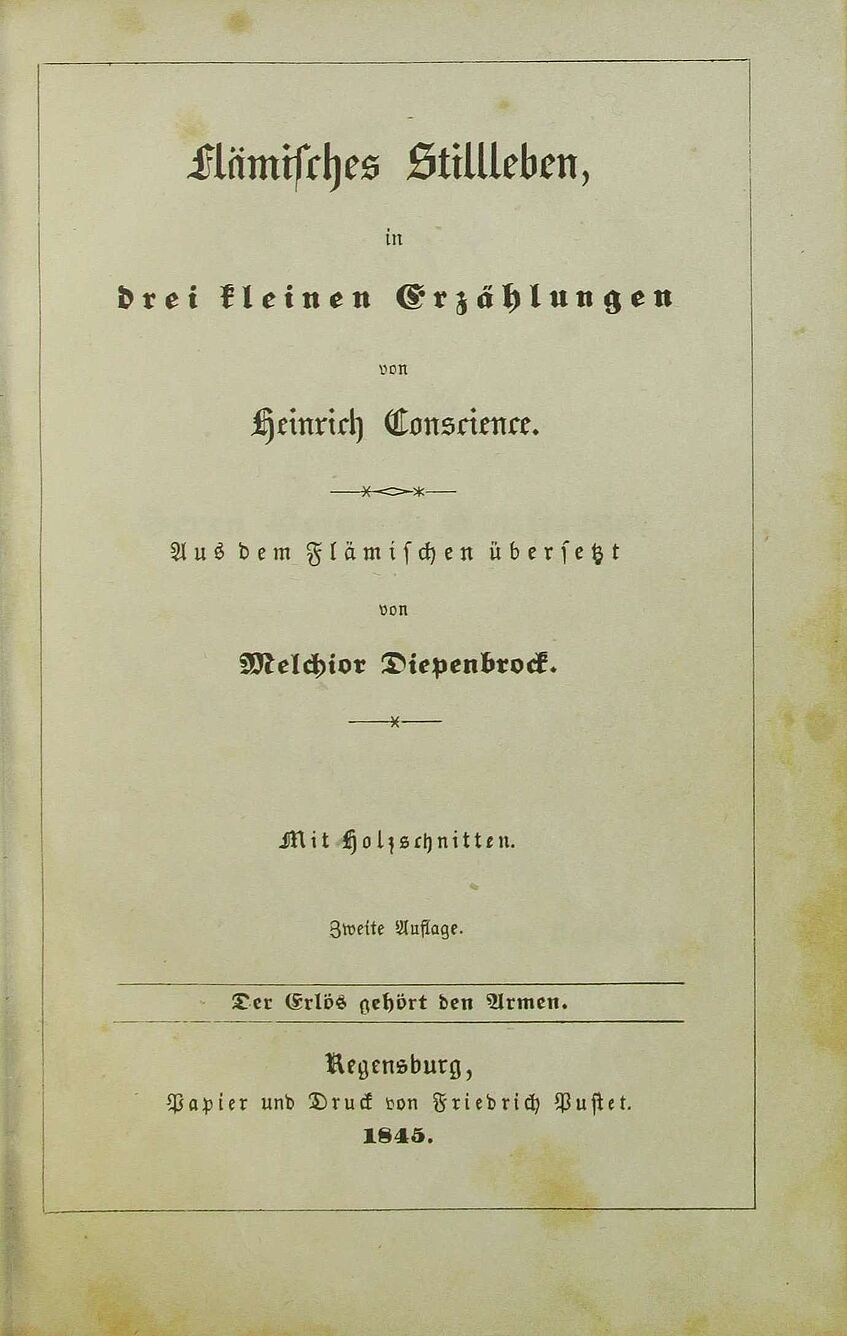Publication History
Publication History
Flämisches Stillleben (1845) is not only the first book publication of translated works by Conscience, it also brings together three texts that were published separately in their original language. Wat eene moeder lijden kan first appeared in 1841 in the Antwerp journal De Noordstar before it was published in book form in 1844 by J.E. Buschmann (Antwerp), illustrated with 50 woodcuts by H. Brown after drawings by J. Mathysen. Hoe men schilder wordt and Siska van Roosemael were published by the same publisher in 1843 and 1844 respectively.
In an anonymous newspaper article from the supplement of the Allgemeine Zeitung (11/7/1844), Conscience was hailed as the main representative of the younger generation of the Flemish Movement. The text also pointed out his popularity among the Flemish audience. The article was part of a series offered to the newspaper by F.A. Snellaert (Deprez 90), with the aim of introducing the Flemish Movement to the readers of the Allgemeine Zeitung. Before presenting Conscience, the article discusses the role and oeuvre of the philologists Jan Frans Willems, Jan Hendrik Bormans, and Jean-Baptist David. According to Von Diepenbrock, it was this newspaper article that brought Conscience’s works to his attention. When the three novellas were consequently given to him by a “clever, Flemish-speaking lady” after a journey to Belgium, he followed her advice and started translating them (Diepenbrock von IX–X). It is very well possible that he meant Luise von Plönnies, who dedicated her Reise-Erinnerungen aus Belgien (Berlin 1845) to "Heinrich Conscience". During her travels in Belgium, she visited several Flemish writers, among them Jan Alfried de Laet, Pieter Frans van Kerckhoven, and Hendrik Conscience. Describing her tour through Antwerp with Conscience, she mentions his works Siska van Roosemael, Wat eene moeder lijden kan and Hoe men schilder wordt being advertised on the corner of the street (Plönnies von 241).
Editions and Publishers
The first edition of Flämisches Stillleben was published 1845 in Regensburg by Friedrich Pustet, who specialized in liturgical publications and had earlier published a collection of sermons by Von Diepenbrock (Leben und Tod, nach Schein und Seyn betrachtet, Regensburg 1837). In the first edition, the first two stories (Siska Rosemal and Wie man Maler wird) are accompanied by the same woodcuts that illustrate the Dutch editions published by Buschmann. This first edition sold out within weeks, as the preface to the second edition mentions. The second edition followed the same year. For this edition, the third story Was eine Mutter leiden kann had also been illustrated with the same woodcuts as the original. The third and fourth edition would follow in 1849 and 1852.
In 1871, a new edition of Flämisches Stillleben was published by Pustet under the title Drei kleine Erzählungen. This edition was reprinted in 1883, the year Conscience died.
Von Diepenbrock’s translations of Siska van Roosemael and Wat eene moeder lijden kan were furthermore published by Hausen (Saarlouis) in 1920 under the title Siska van Rosemal, as the 105th volume of the Hausens Bücherei series.
Other Translations
Melchior von Diepenbrock was not the first to translate Conscience's novellas into German. In 1842, an anonymous translation of Wat eene moeder lijden kan had already appeared in the journal Die Grenzboten, only one year after its first publication in De Noordstar.
The same year Flämisches Stillleben appeared, the Hallberger'sche Verlagsbuchhandlung published Familien-Bilder (Stuttgart 1845), consisting of Siska van Roosemael and Hoe men schilder wordt in a translation by L. Mauch. Familien-Bilder appeared as the 32nd volume in the series Aula der schönen Literatur.
One year later, the Aschendorff’sche Buchhandlung published a different translation of Wat eene moeder lijden kan, Siska van Roosemael, and Hoe men schilder wordt under the title Drei Erzählungen (Münster 1846). The catholic publishing house was the main publisher of Conscience’s works in German (see statistics). Drei Erzählungen appeared as the eighth volume of the Sammlung ausgewählter Schriften von Heinrich Conscience, a series of Conscience’s collected works that was published between 1846 and 1884 and counted 75 volumes in total. Drei Erzählungen experienced its ninth and last reprint in 1903.
Most important Publishers of Conscience in German
Translations of 'Wat eene moeder lijden kan'
Select Bibliography
Deprez, Ada. Briefwisseling van dr. Ferdinand Augustijn Snellaert (1809-1872). I. Bronnenbeschrijving. Lijst van brieven en documenten. Koninklijke Academie voor Nederlandse Taal- en Letterkunde, 1977.
Diepenbrock von, Melchior. “Vorrede.” Flämisches Stillleben, in drei kleinen Erzählungen, Friedrich Pustet, 1845, pp. VII–XIV.
Plönnies von, Luise. Reise-Erinnerungen aus Belgien. Duncker & Humblot, 1845.
Simons, Ludo. Het boek in Vlaanderen sinds 1800. Een cultuurgeschiedenis. Lannoo, 2013.
“Die Flämische Litteratur Und Ihre Hervorragenden Schriftsteller.” Augsburger Allgemeine Zeitung, 11 July 1844, pp. 1539–40.
Van Uffelen, Herbert. Moderne niederländische Literatur im deutschen Sprachraum 1830-1990. Zentrum für Niederlande-Studien, 1993.

